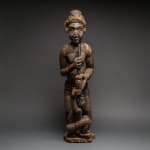Bamileke Wooden Sculpture of a Woman and Child, 19th Century CE - 20th Century CE
Wood
108 x 27.9 cm
42 1/2 x 11 in
42 1/2 x 11 in
PF.4690 (LSO)
Further images
This powerful old figure of a woman and child was made by one of the Grasslands peoples of Cameroon, probably the Bamileke. It shows a standing woman of status, as...
This powerful old figure of a woman and child was made by one of the Grasslands peoples of Cameroon, probably the Bamileke. It shows a standing woman of status, as indicated by her bracelets, ornate loincloth and extravagant coiffure/headwear. She is also smoking a highly decorated pipe, and the child is not in a pose indicative of maternity figures – rather he (?) is squatting before her and lifting his hands in supplication. The rendering is extremely impressive, with details of muscles and other anatomical characteristics picked out with exquisite care. The face is set in the traditional Bamileke grimace, with bared teeth, a sharp nose and rimmed almond-shaped eyes. Her hat is encrusted with fabric and dark material that is presumably the remains of libations.
The Bamileke are one of many Bantu-speaking groups who live on the high Grasslands plateau of the Cameroons. They are themselves divided into over one hundred groups which approximate to chiefdoms under the rule of a Fon (king), and have internal subdivisions (including the Bafang, Bafoussam, Bandjoun, Bangante, Bawaju, Dschang, and Mbouda) that had a higher significance prior to the arrival of the European colonial forces; today they are generally considered to be a single entity. They migrated into the area with the Tikar and Bamun prior to the 17th century in order to avoid the Fula invasion of the Adamawa Plateau, and there were at least four further waves of migration. Their society is largely agricultural, and village units are based around large agrarian plots that are technically owned by the fon, who is accorded political, economic and spiritual powers over the populace. His power is balanced by a council of nobles known as the Kamveu, and he is personally influenced by his mother, the Mafo.
The Bamileke are Christian, Islamic and animist. The latter still produce paraphernalia to assist them in ancestor worship, which is achieved through retention and spiritual manipulation of their forefather’s skulls. Health is maintained through traditional medicine, while they also use a divination method similar to that of the Baule mouse oracle, but involving a spider. Most of their large sculptures represent members of the royal family and their antecedents, and were usually displayed in a court context and during ceremonies to manifest the fon’s authority.
This may represent an important woman of the court, most likely the queen mother herself. Whatever she represents, however, this is a powerful and important piece of courtly paraphernalia, which would be a credit to any collection of the genre.
The Bamileke are one of many Bantu-speaking groups who live on the high Grasslands plateau of the Cameroons. They are themselves divided into over one hundred groups which approximate to chiefdoms under the rule of a Fon (king), and have internal subdivisions (including the Bafang, Bafoussam, Bandjoun, Bangante, Bawaju, Dschang, and Mbouda) that had a higher significance prior to the arrival of the European colonial forces; today they are generally considered to be a single entity. They migrated into the area with the Tikar and Bamun prior to the 17th century in order to avoid the Fula invasion of the Adamawa Plateau, and there were at least four further waves of migration. Their society is largely agricultural, and village units are based around large agrarian plots that are technically owned by the fon, who is accorded political, economic and spiritual powers over the populace. His power is balanced by a council of nobles known as the Kamveu, and he is personally influenced by his mother, the Mafo.
The Bamileke are Christian, Islamic and animist. The latter still produce paraphernalia to assist them in ancestor worship, which is achieved through retention and spiritual manipulation of their forefather’s skulls. Health is maintained through traditional medicine, while they also use a divination method similar to that of the Baule mouse oracle, but involving a spider. Most of their large sculptures represent members of the royal family and their antecedents, and were usually displayed in a court context and during ceremonies to manifest the fon’s authority.
This may represent an important woman of the court, most likely the queen mother herself. Whatever she represents, however, this is a powerful and important piece of courtly paraphernalia, which would be a credit to any collection of the genre.
Literature
V24







